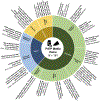Communicative appeals and messaging frames in visual media for HIV pre-exposure prophylaxis promotion to cisgender and transgender women
- PMID: 36074902
- PMCID: PMC9992445
- DOI: 10.1080/13691058.2022.2116111
Communicative appeals and messaging frames in visual media for HIV pre-exposure prophylaxis promotion to cisgender and transgender women
Abstract
Women in the USA represent 15% of new HIV diagnoses but only 5% of pre-exposure prophylaxis (PrEP) users. We sought to characterise communicative appeals and messaging frames used in US visual media to cultivate PrEP demand among cisgender and transgender women using content analysis methodology. We catalogued and coded media items (images and videos) from US PrEP marketing campaigns featuring women. Production and content characteristics were abstracted, and communicative appeals from media items were qualitatively coded in duplicate. We then descriptively summarised production and content characteristics and identified discrete subgroups of media items, clustering around specific messaging frames, through qualitative thematic analysis. Racial/ethnic minorities and sexual/gender minority women were heavily featured, and numerous media items leveraged cognitive and social communicative appeals to promote PrEP. We identified three unique messaging frames emerging from coded media items, portraying PrEP as: (1) necessary prevention (protection frame), (2) a desirable yet accessible commodity (aspiration frame), and (3) a conduit to sexual autonomy (empowerment frame). To effectively communicate PrEP information and promote PrEP to women, PrEP marketing should leverage alternative appeals (subjective norms, self-efficacy), address anticipated barriers to uptake (stigma, cost, medication interactions), and deconstruct misconceptions of PrEP use(rs).
Keywords: Content analysis; HIV prevention; PrEP; health communication; mixed methods research.
Conflict of interest statement
Disclosure statement
The authors have no conflicts of interest to disclose.
Figures


Similar articles
-
Preferences for Injectable PrEP Among Young U.S. Cisgender Men and Transgender Women and Men Who Have Sex with Men.Arch Sex Behav. 2018 Oct;47(7):2101-2107. doi: 10.1007/s10508-017-1049-7. Epub 2017 Sep 19. Arch Sex Behav. 2018. PMID: 28929260
-
Exploring barriers and facilitators to PrEP use among transgender women in two urban areas: implications for messaging and communication.BMC Public Health. 2022 Jan 6;22(1):17. doi: 10.1186/s12889-021-12425-w. BMC Public Health. 2022. PMID: 34991548 Free PMC article.
-
Sexual and Gender Minority Adolescents' Preferences for HIV Pre-Exposure Prophylaxis Social Marketing Campaigns: Qualitative Preimplementation Study.JMIR Form Res. 2025 Jan 17;9:e60398. doi: 10.2196/60398. JMIR Form Res. 2025. PMID: 39819751 Free PMC article.
-
Pre-Exposure Prophylaxis (PrEP) for HIV Infection in Cisgender and Transgender Women in the U.S.: A Narrative Review of the Literature.Arch Sex Behav. 2021 May;50(4):1713-1728. doi: 10.1007/s10508-020-01903-8. Epub 2021 Jun 1. Arch Sex Behav. 2021. PMID: 34075504 Free PMC article. Review.
-
Assessing PrEP messaging and communication: A review of the qualitative literature.Curr Opin Psychol. 2023 Jun;51:101586. doi: 10.1016/j.copsyc.2023.101586. Epub 2023 May 5. Curr Opin Psychol. 2023. PMID: 37247445 Review.
Cited by
-
Optimizing the pipeline of multipurpose prevention technologies: opportunities across women's reproductive lifespans.Front Reprod Health. 2023 May 30;5:1169110. doi: 10.3389/frph.2023.1169110. eCollection 2023. Front Reprod Health. 2023. PMID: 37325241 Free PMC article. Review.
-
A decade of PrEP: the evolution of HIV pre-exposure prophylaxis content and sentiments in South African print news media, 2012-2021.Cult Health Sex. 2024 Dec;26(12):1618-1634. doi: 10.1080/13691058.2024.2344111. Epub 2024 Apr 24. Cult Health Sex. 2024. PMID: 38656915
-
HIV Prevention and Sexual Health Conversations Among Women in Ending the HIV Epidemic Priority Communities: A Qualitative Exploration of Experiences and Preferences.Arch Sex Behav. 2025 Apr;54(4):1537-1553. doi: 10.1007/s10508-025-03108-3. Epub 2025 Mar 18. Arch Sex Behav. 2025. PMID: 40102279
References
-
- Babalola S 2017. “Changes in Ideational Profiles of Women of Reproductive Age in Urban Nigeria: The Role of Health Communication.” Health Education & Behavior 44 (6): 907–917. - PubMed
-
- Babalola S, and Vonrasek C. 2005. “Communication, Ideation and Contraceptive Use in Burkina Faso: An Application of the Propensity Score Matching Method.” The Journal of Family Planning and Reproductive Health Care 31 (3): 207–212. - PubMed
-
- Bastien S 2011. “Fear Appeals in HIV-Prevention Messages: Young People’s Perceptions in Northern Tanzania.” African Journal of AIDS Research 10 (4): 435–449. - PubMed
-
- Bradley E, Forsberg K, Betts JE, DeLuca JB, Kamitani E, Porter SE, Sipe TA, and Hoover KW. 2019. “Factors Affecting Pre-Exposure Prophylaxis Implementation for Women in the United States: A Systematic Review.” Journal of Women’s Health (2002) 28 (9): 1272–1285. - PubMed
Publication types
MeSH terms
Substances
Grants and funding
LinkOut - more resources
Full Text Sources
Medical
Miscellaneous
